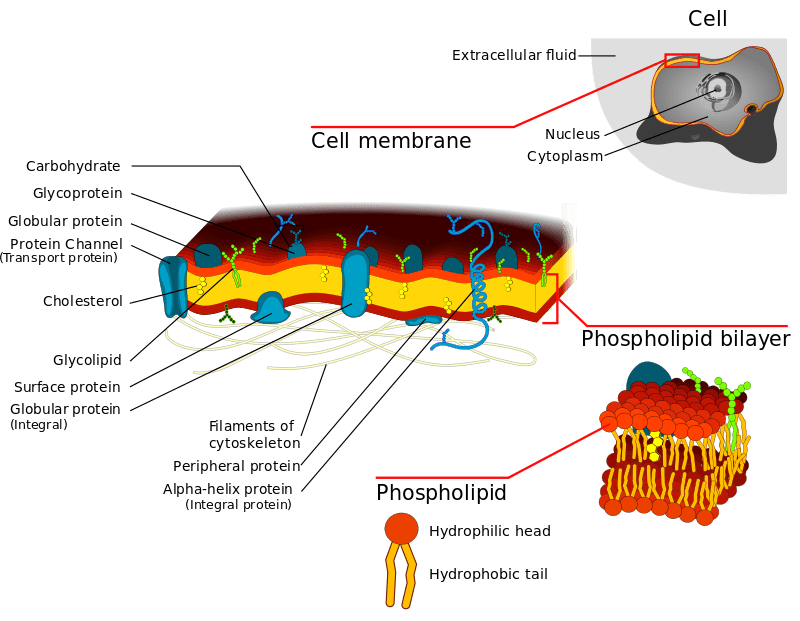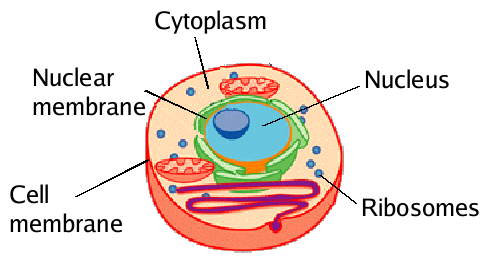Difference Between Cell Membrane and Cytoplasm
Table of Contents
Key Difference – Cell Membrane vs Cytoplasm
The cell is the highly organized basic building block of the living organisms. Cell membrane and cytoplasm are two major components of a cell. Their function and structure are highly important for the survival and development of the living cell. The cell membrane is a dynamic, delicate, two-layered structure made up of lipids and proteins. The main function of the cell membrane is the regulation of the movements of substances in and out of the cell. Cytoplasm is the semifluid matrix located inside the plasma membrane and outside of the nucleus in which all the other cell organelles are embedded. The key difference between Cell Membrane and Cytoplasm is, the cell membrane is the semi-permeable protective cover that encloses the entire cell including the cytoplasm while the cytoplasm is the transparent jelly-like semi-fluid present within the cell membrane and nucleus that fills the entire cell.
CONTENTS
1. Overview and Key Difference
2. What is Cell Membrane
3. What is Cytoplasm
4. Similarities Between Cell Membrane and Cytoplasm
5. Side by Side Comparison – Cell Membrane vs Cytoplasm in Tabular Form
6. Summary
What is Cell Membrane?
The cell membrane (plasma membrane) is defined as the double-layered phospholipid membrane that separates the interior of the cell from the outside environment in both prokaryotic and eukaryotic cells. Singer and Nicolson first described the cell membrane structure in 1972. According to fluid mosaic model explained by Singer and Nicolson, the phospholipids in the plasma membrane are made up of hydrophilic phosphate heads and hydrophobic fatty acid tails. The phospholipids are arranged in a way directing their hydrophobic tails inward and hydrophilic heads outward.
There are two phospholipid layers present in the cell membrane. Within the phospholipid bilayer, different types of proteins are located. The three types of proteins are integral proteins, peripheral proteins and transmembrane proteins. Some proteins span all the way through the membrane and serve as channels or cell receptors while others can be found on the edge of the cell membrane attached to the carbohydrates (glycoprotein). The cholesterol may also be found in the plasma membrane. Cholesterol affects the fluidity of the plasma membrane.

Figure 01: Cell Membrane
The main function of the cell membrane is the protection of cell from its surrounding. It limits the exchange of materials between the cell and its environment (acts as a selectively permeable membrane). Some cells have modified plasma membranes. For example, the plasma membranes of nutrient-absorbing cells in small intestine, the membrane is folded into finger-like projections known as ‘microvilli’. This modification increases the surface area of the plasma membrane. And also it increases the efficiency of the nutrients absorption.
What is Cytoplasm?
The cytoplasm is defined as the jelly-like semifluid matrix presents in between the nuclear envelope and the cell membrane in eukaryotes. But in case of prokaryotic cells, it is defined as the jelly-like semi-fluid that finds inside the plasma membrane. The cytoplasm has jelly-like “cytosol” known as an aqueous component of the cytoplasm. The cytosol contains water, ions, small molecules and macromolecules. The eukaryotic cell also has the membrane-bound organelles in the cytosol.

Figure 02: Cytoplasm
The cytoskeleton is a network of fibres that finds in the cytoplasm. The cytoskeleton gives shape to the cell, and it supports the cell too. Many proteins are suspended in the cytoplasm. It contains other molecules like sugars, carbohydrates, lipids and ions such as; sodium, potassium and calcium. The many metabolic reactions are taken place in the cytoplasm. It functions as a reaction media.
What are the Similarities Between Cell Membrane and Cytoplasm?
- Both are components of a cell.
- Both are responsible for giving a shape to the cell.
- Both are highly important for the survival of the cell.
- Proteins, lipids, carbohydrates can be found in both cell membrane and cytoplasm.
What is the Difference Between Cell Membrane and Cytoplasm?
Cell Membrane vs Cytoplasm | |
| The cell membrane is defined as the double-layered phospholipids membrane that separates the interior of the cell from the outside environment. | The cytoplasm is defined as the jelly-like semi-fluid presents inside the plasma membrane. |
| Function | |
| Cell membrane protects the cell and gives a definite shape to the cell. | Cytoplasm holds the cell organelles and acts as a reaction media for metabolic reactions. |
| Protoplasm | |
| The cell membrane is not a part of the protoplasm. | Cytoplasm and nucleus are the parts of the protoplasm. |
| Movement of Substances | |
| The cell membrane has tiny pores that control the movement of the various substances across the membrane. | Cytoplasm does not involve in the control of the movement of the various substances across the membrane. |
| Separation from the Outside Environment | |
| Cell membrane separates the cells from one another and from the outside environment. | Cytoplasm does not separate the cells from one another and from the outside environment. |
| Stored and Released Energy | |
| The energy is not released and stored in the cell membrane. | The energy is released and stored in the cytoplasm. |
| Cell Adhesion and Ion Conductivity | |
| The cell membrane is the main site that involves in cell adhesion and ion conductivity. | Cytoplasm does not involve in cell adhesion and ion conductivity. |
Summary – Cell Membrane vs Cytoplasm
The cell is the basic unit of the biology. And it was discovered by English Scientist Robert Hooke in 1665. The cell has basic components such as cell membrane, cytoplasm, cell organelles and a nucleus stored with genetic material. The cell membrane is the protective sheet that covers the entire cell. The cytoplasm and nucleus collectively make the living part of the cell called protoplasm. Cytoplasm is considered as the jelly-like semi-fluid that presents in between the nuclear envelope and the cell membrane in eukaryotes. But in case of prokaryotic cells, it is the jelly-like semi-fluid finds inside the plasma membrane. The cytoplasm provides a reaction media for cells’ metabolic reactions. The cytoplasm also holds many of the cell organelles. This is the difference between cell membrane and cytoplasm.
Download the PDF Version of Cell Membrane vs Cytoplasm
You can download PDF version of this article and use it for offline purposes as per citation note. Please download PDF version here Difference Between Cell Membrane and Cytoplasm
Reference:
1.“Plasma membrane and cytoplasm (Article).” Khan Academy. Available here
2.“Cell membrane and Cytoplasm – Cell structure and functions, Class 8.” ClassNotes.org.in, 19 Oct. 2016. Available here
Image Courtesy:
1.’Cell membrane detailed diagram 3’By derivative work: Dhatfield, (CC BY-SA 3.0) via Commons Wikimedia
2.’Cell parts’ By No machine-readable author provided. Own work assumed (based on copyright claims)., (CC BY-SA 3.0) via Commons Wikimedia
ncG1vNJzZmivp6x7pbXFn5yrnZ6YsqOx07CcnqZemLyue8OinZ%2Bdopq7pLGMm5ytr5Wau26vxKWjZqWVoq%2Bzrc2eZJqmlGLDtHnCsquoqJyWwK57